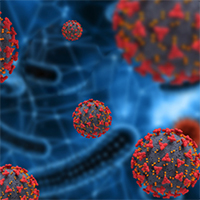Role of awake prone positioning in patients with moderate-to-severe COVID-19: an experience from a developing country

Submitted: August 11, 2020
Accepted: December 1, 2020
Published: March 5, 2021
Accepted: December 1, 2020
Abstract Views: 3823
PDF: 1869
Publisher's note
All claims expressed in this article are solely those of the authors and do not necessarily represent those of their affiliated organizations, or those of the publisher, the editors and the reviewers. Any product that may be evaluated in this article or claim that may be made by its manufacturer is not guaranteed or endorsed by the publisher.
All claims expressed in this article are solely those of the authors and do not necessarily represent those of their affiliated organizations, or those of the publisher, the editors and the reviewers. Any product that may be evaluated in this article or claim that may be made by its manufacturer is not guaranteed or endorsed by the publisher.
Similar Articles
- Tiziana Ciarambino, Elena Barbagelata, Graziamaria Corbi, Immacolata Ambrosino, Cecilia Politi, Franco Lavalle, Anna Ruggieri, Annamaria Moretti, Gender differences in vaccine therapy: where are we in COVID-19 pandemic? , Monaldi Archives for Chest Disease: Vol. 91 No. 4 (2021)
- F. Nicosia, L. Giordano, L. Bonini, L. Corda, M. Bolzon, M. Bettinzoli, A. Braghini, P. Accorsi, C. Tantucci, Hyperventilation and seizures in an adolescent female , Monaldi Archives for Chest Disease: Vol. 79 No. 2 (2013): Pulmonary series
- Nitish Aggarwal, Tarun Krishna Boppana, Saurabh Mittal, COVID-19 pandemic: The testing times for healthcare workers , Monaldi Archives for Chest Disease: Vol. 91 No. 1 (2021)
- Abdula Elawady, Ahmed Khalil, Omar Assaf, Samirah Toure, Christopher Cassidy, Telemedicine during COVID-19: a survey of Health Care Professionals’ perceptions , Monaldi Archives for Chest Disease: Vol. 90 No. 4 (2020)
- S.M. Tariq, J. George, S. Srinivasan, Inhaled foreign bodies in adolescents and adults , Monaldi Archives for Chest Disease: Vol. 63 No. 4 (2005): Pulmonary series
- Nicola Corcione, Paolo Ferraro, Michele Polimeno, Stefano Messina, Vincenzo de Rosa, Arturo Giordano, A case of percutaneous coronary intervention after transfemoral implantation of a Medtronic CoreValve Systemâ„¢ , Monaldi Archives for Chest Disease: Vol. 76 No. 4 (2011): Cardiac series
- Kevin John, Amos Lal, Ajay Mishra, A review of the presentation and outcome of Takotsubo cardiomyopathy in COVID-19 , Monaldi Archives for Chest Disease: Vol. 91 No. 3 (2021)
- Francesco Fattirolli, Position ANDID on: The role of Dietitian in cardiac rehabilitation and prevention. A comment , Monaldi Archives for Chest Disease: Vol. 70 No. 3 (2008): Cardiac series
- Nitin Goel, Nitesh Goyal, Raj Kumar, Clinico-radiological evaluation of post COVID-19 at a tertiary pulmonary care centre in Delhi, India , Monaldi Archives for Chest Disease: Vol. 91 No. 3 (2021)
- M. Fernandes, A. Cukier, N. Ambrosino, J.J. Leite, M.I. Zanetti Feltrim, Respiratory pattern, thoracoabdominal motion and ventilation in chronic airway obstruction , Monaldi Archives for Chest Disease: Vol. 67 No. 4 (2007): Pulmonary series
<< < 2 3 4 5 6 7 8 9 10 11 > >>
You may also start an advanced similarity search for this article.

 https://doi.org/10.4081/monaldi.2021.1561
https://doi.org/10.4081/monaldi.2021.1561





